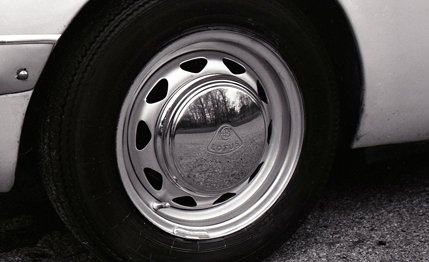As befits a Chapman design, the Elan’s cornering power is simply phenomenal. It’s a considerable improvement on the 1955 Lotus 11, which first established modern standards for high-speed small-displacement sports cars. Going through a corner progressively faster with the Elan, it first drifts, then slides and makes a low cat-like growl when the limit of propriety is approached. It then crouches and goes still faster. But there is never anything untoward or unexpected—everything merely happens faster than with other cars because this one can be cornered faster.
The car has absolutely neutral handling characteristics, and wonderfully quick steering response with all the accuracy of a racing machine. And just like the old Lotus 11, the car won’t do anything funny if the driver uses the brakes well into a corner—it will stay right on the intended line. Changes in throttle opening affect its course so slightly as to be of no moment.
Our test car was fitted with Goodyear Tubeless tires, a mistake that the importer was happy to acknowledge. Later cars will be fitted with a more suitable Dunlop tire, and the car will undoubtedly be more controllable in the wet and quieter during cornering on the dry.
|
|
For a large driver, the Lotus Elan borders on being too small. Pedal placement is as good as possible, but the narrow tunnel just doesn’t give enough space for really good location. As a result, heeling-and-toeing is possible for the big-footed, but you ought to wear nice tight shoes to try it. The brake foot tends to catch a bit of the gas pedal when you don’t want it to, and you have to slide your clutch foot under the clutch pedal to rest it—or to dim the lights. We found ourselves lifting only our toe to get off the accelerator pedal, and thinking the throttle was stuck; it was just that we were still holding the gas pedal down with the arch of our foot. Detail changes are planned.
The result of all this is that a larger driver will feel unnaturally clumsy in the tiny car, as a first impression. The evidence of a quick and vital kind of response is so apparent that he’ll blame himself, feeling guilty for manhandling a thoroughbred. Then, as miles accumulate, things start falling into place, and the driving procedure becomes a kind of whirling tap-dance, with only a touch needed here and there, a soft, light, effortless controllability. But it is truer of the Elan than of most cars that you need to put some time in before the car begins to work properly for you.
The seats of the Elan are less extreme in the angle of reclining than on any other Lotus, including the Elite. The backrests are not adjustable, but the fixed angle will suit most drivers who prefer a straight-arm position. Short drivers are aided in their efforts to see out by the fact that the seat moves upward as it is moved forward.
Attractive is unquestionably the word for the interior, which is nice but not terribly practical. There’s a shortage of stowage space almost as striking as in the XK-E and ridiculously small ashtrays built into the door panels. The instrument panel is spartan compared with such cars as the Sunbeam Alpine, but we must admit we found it adequate.
|
|
Weather protection is a chronic problem with all sports cars, and the Elan is no exception. There are water leaks by the door posts, and the windows juggle down from a closed position as the car progresses, creating drafts and leaks galore. But what the hell—it’s still better than many sports cars that we have come to accept as they are (and try to drive only on nice days). The floor of the Elan is as tight as a space suit, so the car can be driven through sizeable pools and puddles without fear of getting wet feet. The Elan’s soft top fits nicely and does not flap in the wind, but does create some noise at speed. Removal of the top is no worse or no better than average for an open British two-seater. One man can complete the operation by himself, but if he’s in a hurry, it’s nice if he has help.
Of the controls in the Elan we have only one strong objection—the handbrake. It’s of the umbrella-handle type and is concealed under the dash. We found we used it very little, while on such cars as the Spitfire, MG-B and Fiat 1500 we employed it very frequently. Handbrakes can be very useful, and the least we can ask is that they be conveniently arranged.
Vacuum-operated retractable headlights have the great advantage over the electrical ones that the delay is only about one second from the time the button is pulled until the headlights are in position. On the Elan the light switch is right next to the retractor button, easily within reach of the right hand.
View Photos
View Photos


Leave a Reply